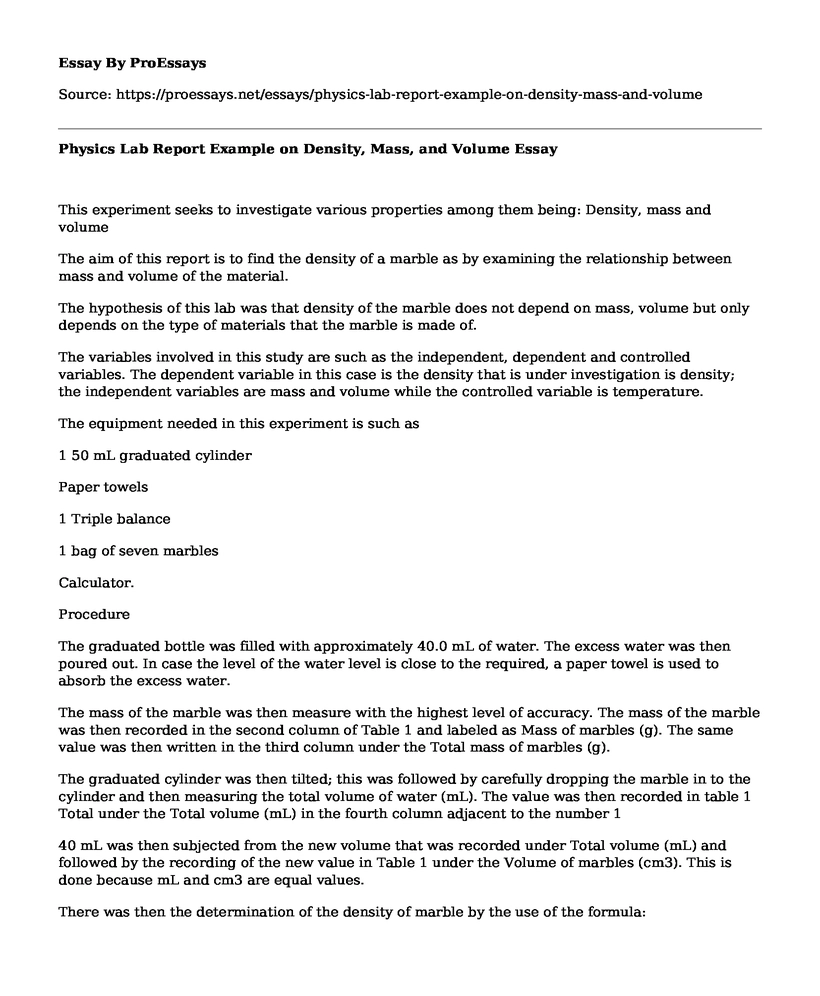This experiment seeks to investigate various properties among them being: Density, mass and volume
The aim of this report is to find the density of a marble as by examining the relationship between mass and volume of the material.
The hypothesis of this lab was that density of the marble does not depend on mass, volume but only depends on the type of materials that the marble is made of.
The variables involved in this study are such as the independent, dependent and controlled variables. The dependent variable in this case is the density that is under investigation is density; the independent variables are mass and volume while the controlled variable is temperature.
The equipment needed in this experiment is such as
1 50 mL graduated cylinder
Paper towels
1 Triple balance
1 bag of seven marbles
Calculator.
Procedure
The graduated bottle was filled with approximately 40.0 mL of water. The excess water was then poured out. In case the level of the water level is close to the required, a paper towel is used to absorb the excess water.
The mass of the marble was then measure with the highest level of accuracy. The mass of the marble was then recorded in the second column of Table 1 and labeled as Mass of marbles (g). The same value was then written in the third column under the Total mass of marbles (g).
The graduated cylinder was then tilted; this was followed by carefully dropping the marble in to the cylinder and then measuring the total volume of water (mL). The value was then recorded in table 1 Total under the Total volume (mL) in the fourth column adjacent to the number 1
40 mL was then subjected from the new volume that was recorded under Total volume (mL) and followed by the recording of the new value in Table 1 under the Volume of marbles (cm3). This is done because mL and cm3 are equal values.
There was then the determination of the density of marble by the use of the formula:
Density = (mass/volume).
The density of the marble was then recorded in Table 1 under Density of marbles (g/cm3). The measurement was rounded off to the nearest tenth.
There was then the measurement and recording of the mass of another marble. The masses were added together and the resulting value recorded in the third column of the table.
The marble was carefully dropped into the graduated cylinder while the previous marble is still in the cylinder. The row of information was then completed in Table 1 the same way as it was done with one marble.
Steps 7 and 8 were repeated while adding one more at a time. The experiment was completed when all the seven marbles had been added.
Data
Number of marbles Mass of marbles (g) Total mass of marbles (g) Total volume of water (mL) Volume of marbles (cm3) Density of marbles (g.cm3)
1 5.2 5.2 72 2 2.6 = 3 g.cm3
2 20.1 25.3 79 9 2.8 = 3 g.cm3
3 5.5 30.8 81 11 2.8 g.cm3
4 20 50.8 89 19 2.7 g.cm3
5 21.1 71.9 96 26 2.8 g.cm3
6 5.5 77.4 99 29 2.7 g.cm3
7 5.5 82.9 100 30 2.8 g.cm3
Initial volume: 70 mL
Analysis
From the experiment, the increase in the number of marbles led to:
Increase in the total number of marbles
The increase in the volume of marbles
The density of marbles remained constant
Plotting a graph of the total mass of marbles from the third column of the Table 1 (as x-axis) against the volume of marbles from the fifth column (y-axis) produced the graph below.
Conclusion
The relationship between the total mass of the marbles and the volume of the marbles is represented by the direction of the best line of fit. In this manner, increase in mass leads to increase in volume.
Cite this page
Physics Lab Report Example on Density, Mass, and Volume. (2021, Mar 23). Retrieved from https://proessays.net/essays/physics-lab-report-example-on-density-mass-and-volume
If you are the original author of this essay and no longer wish to have it published on the ProEssays website, please click below to request its removal:
- Application Assignment on Math
- Flow Rates vs. Equilibrium
- Mexican Fire Opals - Essay Sample
- Paper Example on Laminar and Turbulent Flow in Smooth Pipes
- Chemical Risks in Nursing: Navigating Hazards for Oncology Nurses - Essay Sample
- Essay Example on Science: Explaining Phenomena and Practical Issues
- Essay Sample on Einstein's Concept of Relativity of Simultaneity







